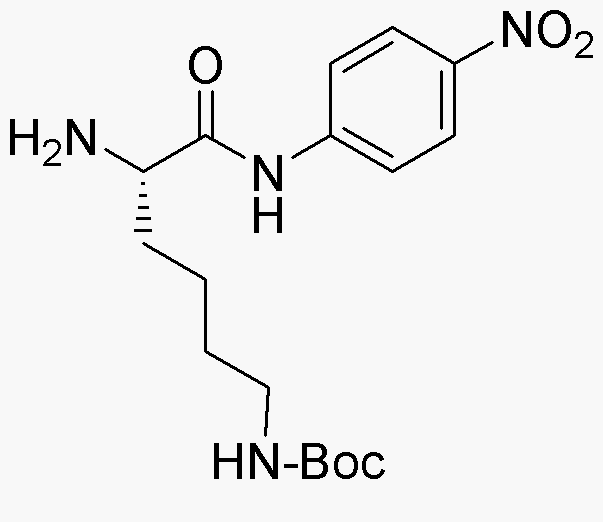Ne-Boc-L-lysine 4-nitroanilide is widely utilized in research focused on:
- Peptide Synthesis: This compound serves as a key building block in the synthesis of peptides, particularly for creating modified peptides with specific functional groups, enhancing the versatility of peptide-based drugs.
- Bioconjugation: It is employed in bioconjugation techniques, allowing researchers to attach biomolecules to surfaces or other molecules, which is crucial in developing targeted drug delivery systems.
- Fluorescent Probes: The compound can be used to create fluorescent probes for imaging applications, helping scientists visualize biological processes in real-time.
- Enzyme Inhibition Studies: It acts as a substrate or inhibitor in enzyme assays, aiding in the study of enzyme kinetics and the development of enzyme inhibitors for therapeutic purposes.
- Drug Development: Its unique structure allows for modifications that can lead to the development of new pharmaceuticals, particularly in the fields of oncology and infectious diseases.
Información general
Propiedades
Seguridad y normativas
Aplicaciones
Ne-Boc-L-lysine 4-nitroanilide is widely utilized in research focused on:
- Peptide Synthesis: This compound serves as a key building block in the synthesis of peptides, particularly for creating modified peptides with specific functional groups, enhancing the versatility of peptide-based drugs.
- Bioconjugation: It is employed in bioconjugation techniques, allowing researchers to attach biomolecules to surfaces or other molecules, which is crucial in developing targeted drug delivery systems.
- Fluorescent Probes: The compound can be used to create fluorescent probes for imaging applications, helping scientists visualize biological processes in real-time.
- Enzyme Inhibition Studies: It acts as a substrate or inhibitor in enzyme assays, aiding in the study of enzyme kinetics and the development of enzyme inhibitors for therapeutic purposes.
- Drug Development: Its unique structure allows for modifications that can lead to the development of new pharmaceuticals, particularly in the fields of oncology and infectious diseases.
Documentos
Hojas de datos de seguridad (HDS)
La SDS proporciona información de seguridad completa sobre la manipulación, el almacenamiento y la eliminación del producto.
Especificación del producto (PS)
La PS proporciona un desglose completo de las propiedades del producto, incluida la composición química, el estado físico, la pureza y los requisitos de almacenamiento. También detalla los rangos de calidad aceptables y las aplicaciones previstas del producto.
Certificados de análisis (COA)
Busque certificados de análisis (COA) ingresando el número de lote del producto. Los números de lote y de partida se pueden encontrar en la etiqueta de un producto después de las palabras "Lote" o "Lote".
Número de catálogo
Número de lote/lote
Certificados de origen (COO)
Este certificado de origen confirma el país en el que se fabricó el producto y también detalla los materiales y componentes utilizados en él y si se deriva de fuentes naturales, sintéticas u otras fuentes específicas. Este certificado puede ser necesario para cumplir con las normativas aduaneras, comerciales y regulatorias.
Número de catálogo
Número de lote/lote
Hojas de datos de seguridad (HDS)
La SDS proporciona información de seguridad completa sobre la manipulación, el almacenamiento y la eliminación del producto.
DownloadEspecificación del producto (PS)
La PS proporciona un desglose completo de las propiedades del producto, incluida la composición química, el estado físico, la pureza y los requisitos de almacenamiento. También detalla los rangos de calidad aceptables y las aplicaciones previstas del producto.
DownloadCertificados de análisis (COA)
Busque certificados de análisis (COA) ingresando el número de lote del producto. Los números de lote y de partida se pueden encontrar en la etiqueta de un producto después de las palabras "Lote" o "Lote".
Número de catálogo
Número de lote/lote
Certificados de origen (COO)
Este certificado de origen confirma el país en el que se fabricó el producto y también detalla los materiales y componentes utilizados en él y si se deriva de fuentes naturales, sintéticas u otras fuentes específicas. Este certificado puede ser necesario para cumplir con las normativas aduaneras, comerciales y regulatorias.


